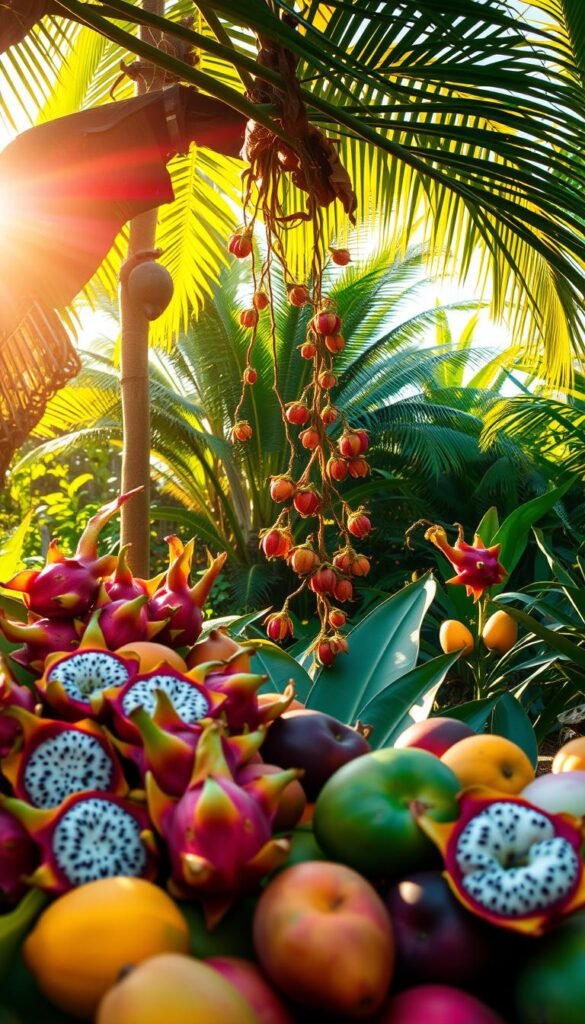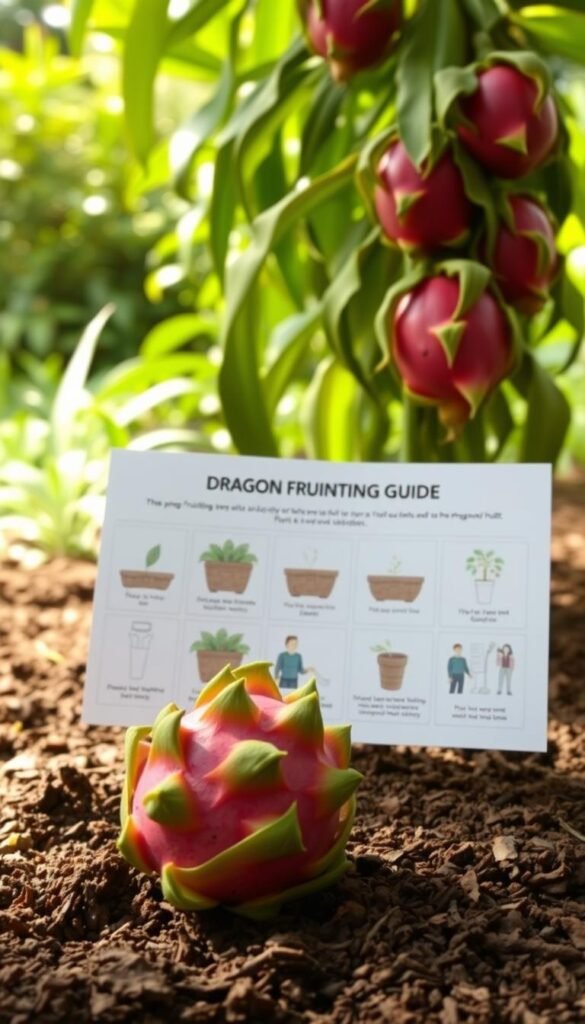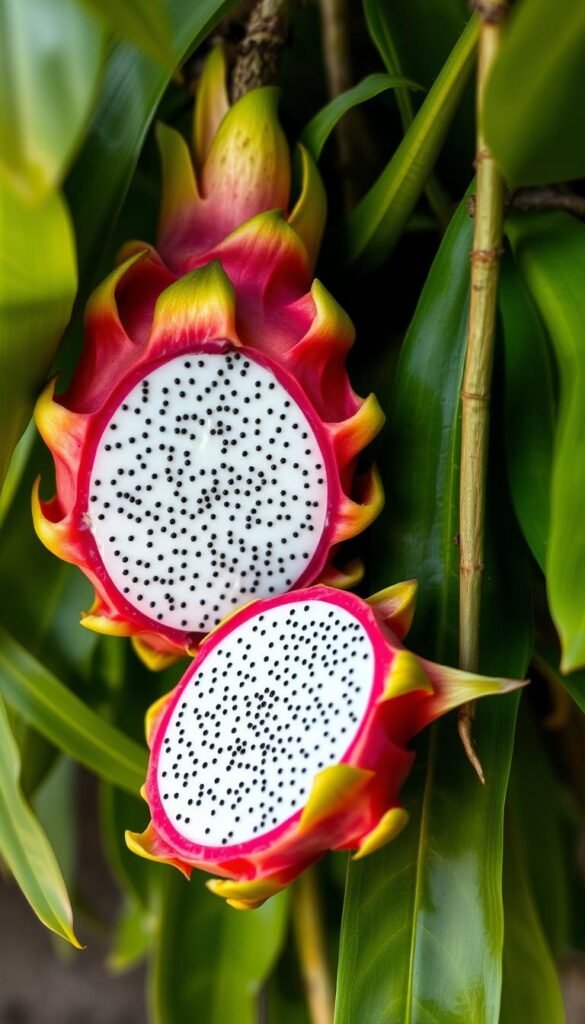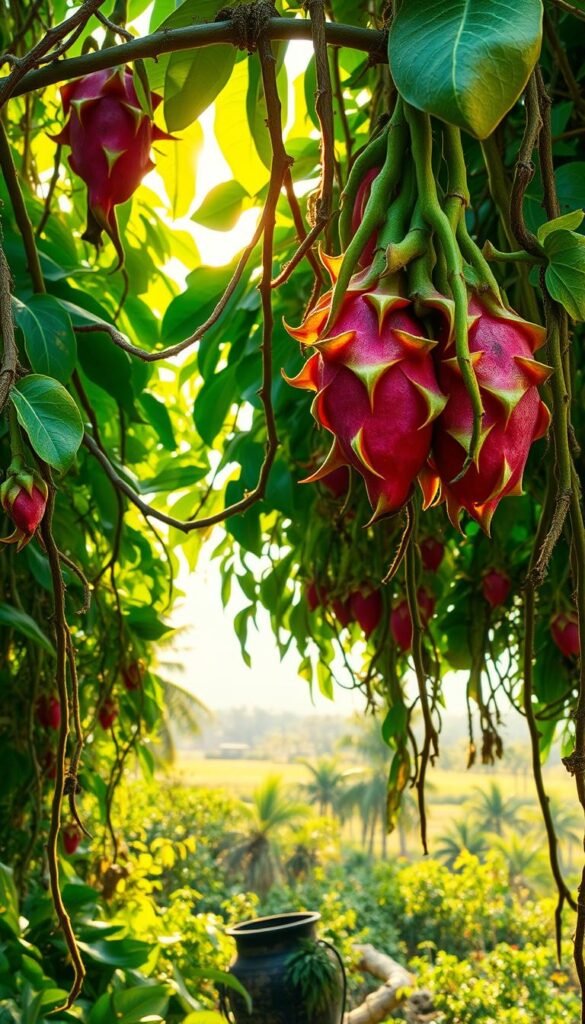Have you ever imagined growing a tropical treasure right in your backyard? This vibrant plant, known for its bold hues and serpent-like vines, offers more than just eye-catching beauty. Its juicy, speckled flesh packs a nutritional punch, making it a favorite among health enthusiasts and gardeners alike.
Originally from Southeast Asia, this cactus species thrives in warm climates but adapts surprisingly well to containers or small spaces. Urban growers love its vertical growth habit, which turns patios into lush, living art displays. With proper care, you can harvest your own crop in as little as two years.
Why has this plant become so popular? It combines stunning visuals with low maintenance needs. The flowers bloom dramatically at night, while the fruit’s pink or yellow skin hides sweet, kiwi-like flesh. Whether you’re a seasoned gardener or just starting out, cultivating these vines brings excitement to any outdoor space.
This guide unlocks practical tips for success. You’ll learn how to choose the best varieties, create ideal growing conditions, and avoid common pitfalls. Get ready to transform your green space with a plant that feeds both your body and imagination.
Dragon Fruit Garden Secrets: Cultivating Exotic Vines at Home

Ready to turn your space into a lush paradise? These vibrant cacti offer more than striking flowers – they bring edible rewards. Let’s explore how to begin your journey with this sun-loving superstar.
Choosing Your Perfect Match
Not all varieties grow alike. White-fleshed types like Hylocereus undatus handle cooler nights better, while red varieties need consistent warmth. Consider these options:
| Type | Flavor Profile | Best For |
|---|---|---|
| White Flesh | Mild, crisp | Coastal climates |
| Red Flesh | Berry-like sweetness | Desert regions |
| Yellow Skin | Honey notes | Container growing |
Climate Tricks for Cooler Zones
Live where winters dip below 40°F? Use movable planters. These plants thrive in daytime heat but need protection when temperatures drop. Southern-facing walls create ideal microclimates.
Propagation surprises beginners – a 12-inch cutting can yield fruit in 18 months. Plant in fast-draining soil mixed with perlite. Water deeply but only when soil dries completely.
In Southeast Asia, farmers train them on concrete posts. You can mimic this with T-shaped trellises. This method saves space and increases air circulation around plants.
Mastering the Art of Dragon Fruit Cultivation

Growing vibrant cacti with edible rewards starts with smart planning. Whether you’re working with a backyard plot or patio containers, two factors determine success: choosing the right starter material and preparing its foundation.
Plant Selection and Soil Preparation
Begin with healthy cuttings or young plants from reputable nurseries. Look for stems showing new growth – these adapt faster to your environment. Coastal areas favor white-fleshed varieties, while desert climates suit sweeter red types.
| Soil Component | Purpose | Ideal Ratio |
|---|---|---|
| Potting Mix | Nutrient Base | 40% |
| Perlite | Drainage | 30% |
| Compost | Organic Matter | 20% |
| Coarse Sand | Aeration | 10% |
Mix components thoroughly before planting. Test pH levels – these plants thrive between 6.0-7.0. Add limestone if your soil leans too acidic.
Planting Techniques, Sunlight, and Watering Tips
Plant cuttings 2-3 inches deep in warm soil, spacing them 6-8 feet apart. Morning sun with afternoon shade prevents leaf burn in hot regions. Water deeply every 14 days, letting soil dry completely between sessions.
Use bamboo stakes or concrete posts for support as stems grow. Rotate container plants weekly for even light exposure. During flowering, switch to low-nitrogen fertilizer to boost fruit development.
Exploring Dragon Fruit Varieties and Urban Garden Inspirations

Unlock a rainbow of flavors and wellness right from your balcony. These stunning plants do more than beautify spaces—they deliver nutritional powerhouses you can harvest yourself. Let’s uncover how different types shine in both taste and function.
Colorful Varieties and Wellness Perks
Each variety offers distinct flavors and health benefits. Red-fleshed options burst with antioxidants called betacyanins, while white-centered types provide gut-friendly prebiotics. Check out these standout choices:
| Variety | Key Feature | Best Use |
|---|---|---|
| Pink Skin/White Flesh | Mild, refreshing | Smoothies |
| Red Skin/Red Flesh | High in vitamin C | Fresh snacks |
| Yellow Skin/White Flesh | Sweet, tropical | Desserts |
The black seeds in every variety add crunch and fiber. Studies suggest regular consumption may reduce inflammation and support digestion. Try adding cubes to yogurt or blending into post-workout shakes.
Smart Space Solutions and Plant Partners
Vertical systems turn walls into productive gardens. Use sturdy trellises to guide vines upward, saving ground space for companions like:
- Basil (repels pests)
- Aloe vera (shares water needs)
- Marigolds (attract pollinators)
This approach creates microclimates that help all plants thrive. Hanging planters work great for balconies—just ensure 6+ hours of sunlight. Pair with succulent arrangements for drought-tolerant beauty that’s practically fuss-free.
Harvesting, Enjoying, and Sustaining Your Exotic Dragon Fruit Garden
After months of nurturing, your patience blooms into vibrant rewards. Watch for color shifts from green to pink or yellow – nature’s signal for peak sweetness. Gently press the skin; a slight give means it’s ready. Twist ripe specimens off the stem to avoid damage.
Slice open your bounty to reveal jewel-toned flesh packed with antioxidants. Add cubes to morning yogurt or blend into sunset-colored smoothies. For savory twists, toss chunks into zesty salads or grill them lightly. Every bite delivers vitamin C boosts and gut-friendly fiber.
Keep plants thriving with seasonal care. Inspect stems weekly for scale insects or fungal spots. Treat issues early using neem oil sprays or improved airflow. After harvesting, prune older growth to energize new branches. Always use clean tools to prevent disease spread.
Celebrate night-blooming flowers that vanish by dawn – their brief beauty starts the fruit-forming magic. Mulch roots before frost and rotate companion plants yearly. With smart care, your living masterpiece keeps yielding tropical treasures season after season.






